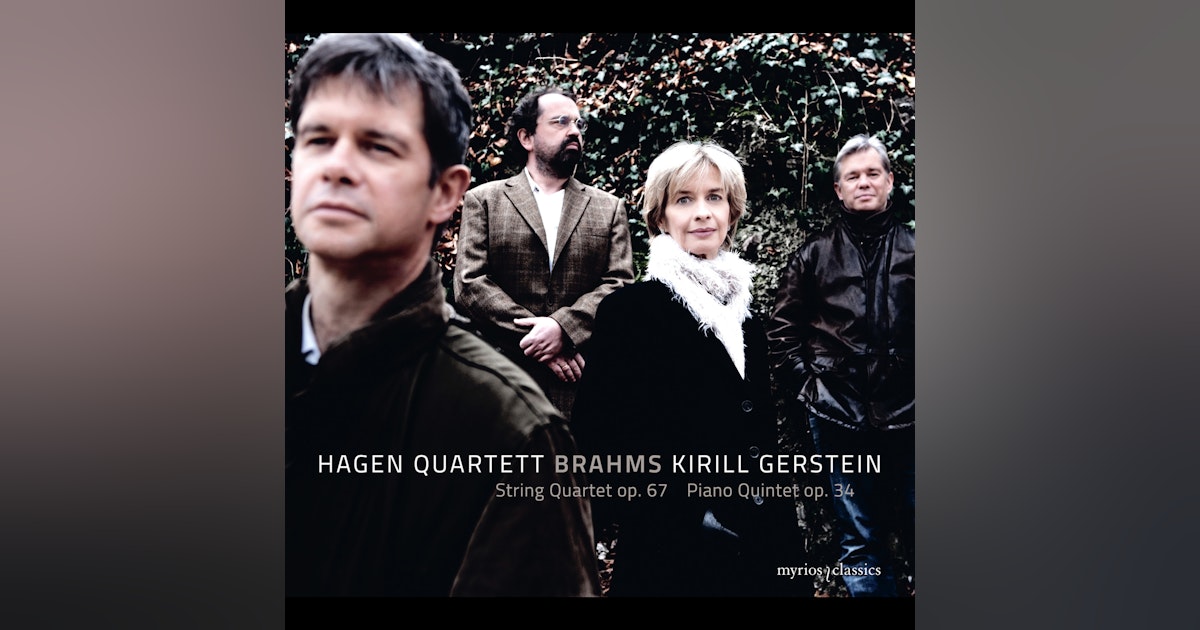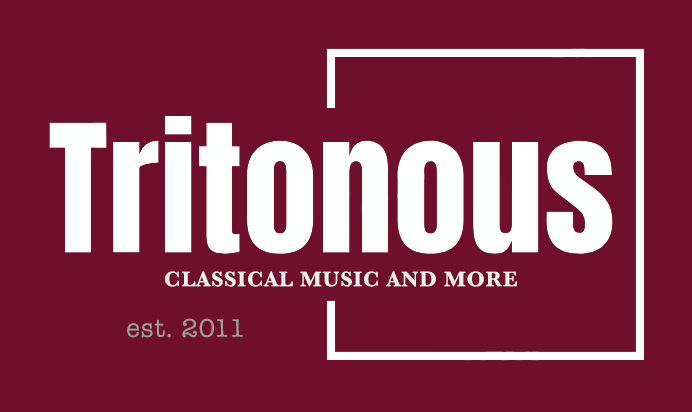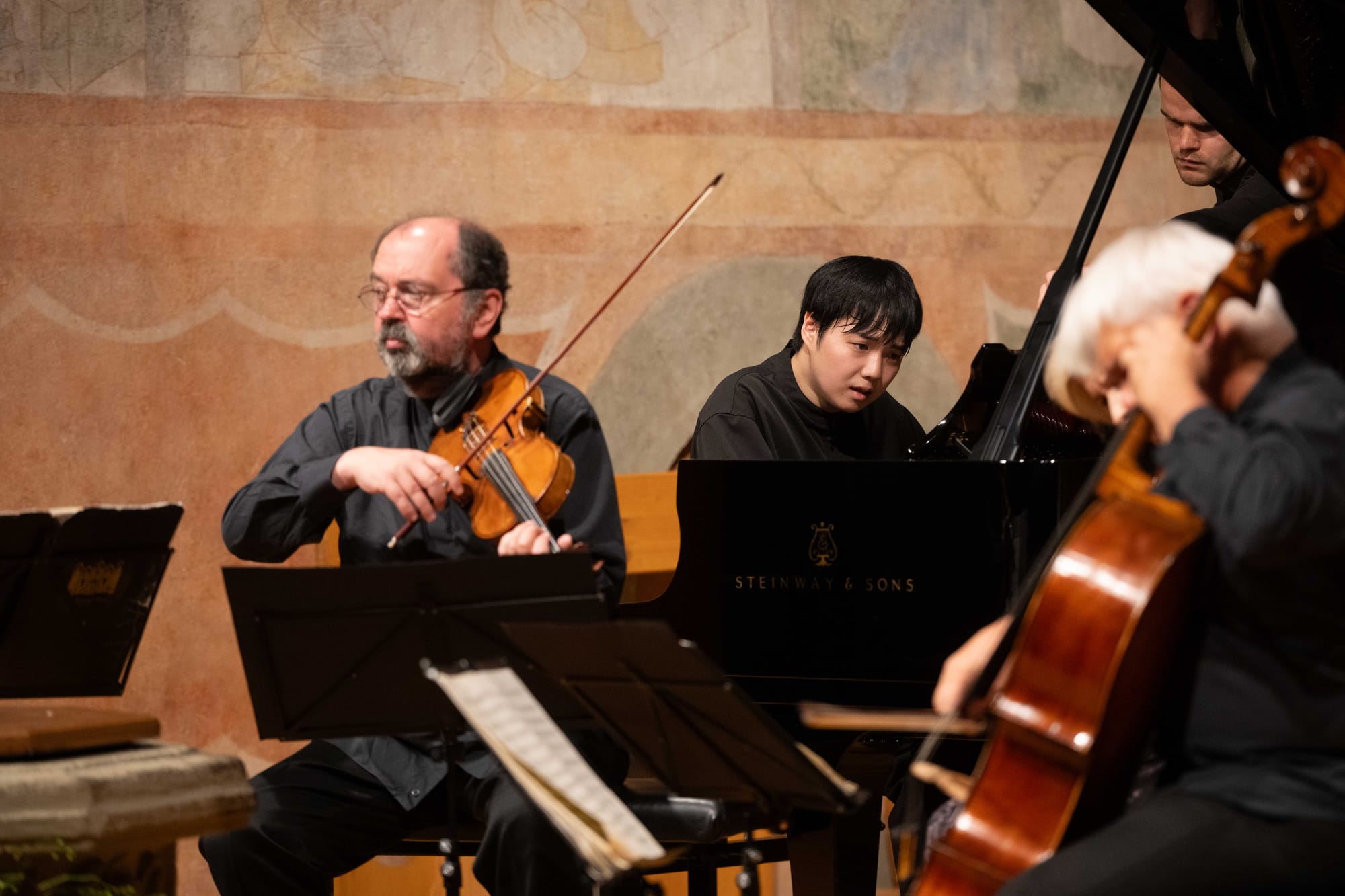
Shostakovich String Quartet No. 3 in A-Major, Op. 72 (1946)
Brahms Piano Quintet in F-Minor, Op. 34 (1865)
Saanen Church, Switzerland, 21.08.2025
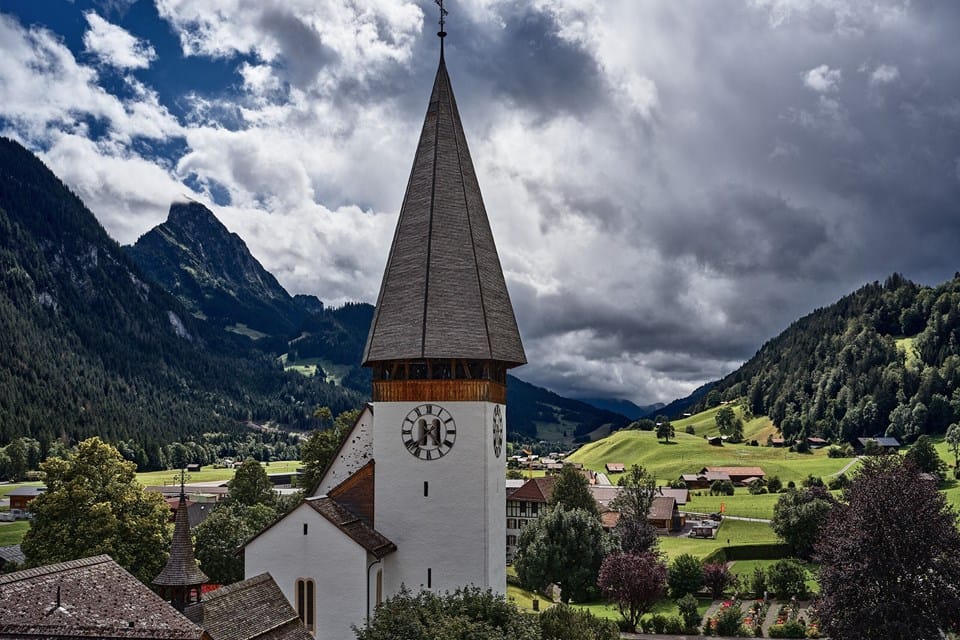
Dedicated to the great Beethoven Quartet, and premiered in Moscow in December 1946, Shostakovich’s Third String Quartet is one of the great under-acknowledged masterpieces, There are five movements, which originally had titles, later withdrawn. It immediately precedes his First Violin Concerto, one of Shostakovich’s greatest works.
The Hagen Quartet has recorded the Third Quartet, though, for Deutsche Grammophon, so they are no strangers to this magnificent score. The church in Saanen is a little more resonant than the venue for the recording, which worked to the performance’s advantage (at least from this close up – three rows in). The Third Quartet’s first movement was originally titled, ‘Calm unawareness of future cataclysm,’ firmly placing this as a war quartet. The almost Haydesque, carefree quality of the opening melody of the first violin (delivered with perfect tuning byLukas Hagen) belies the depths available later. Described in the programme notes for this concert as a ‘carefree reminiscence of the 1930s,’ this movement was heard in a performance characterised by perfect balance between instruments. Veronika Hagen’s viola spoke with impeccable projection and great warmth, the whole closing off with a musical raise eyebrow.
The second movement was originally ‘rumblings of unrest and anticipation’: the music moves from E-Major to F-Minor. Ostinato is a key factor here, the opening’s delivered with force by Veronika Hagen before ceding to cellist Clemens Hagen. But it was the quiet intensity of four musicians playing perfectly together that so impressed. There was bite, too; preparatory to the march-scherzo (‘The forces of war are unleashed’). The move to G sharp-Minor seems to underline the impact of this unrelenting tract.
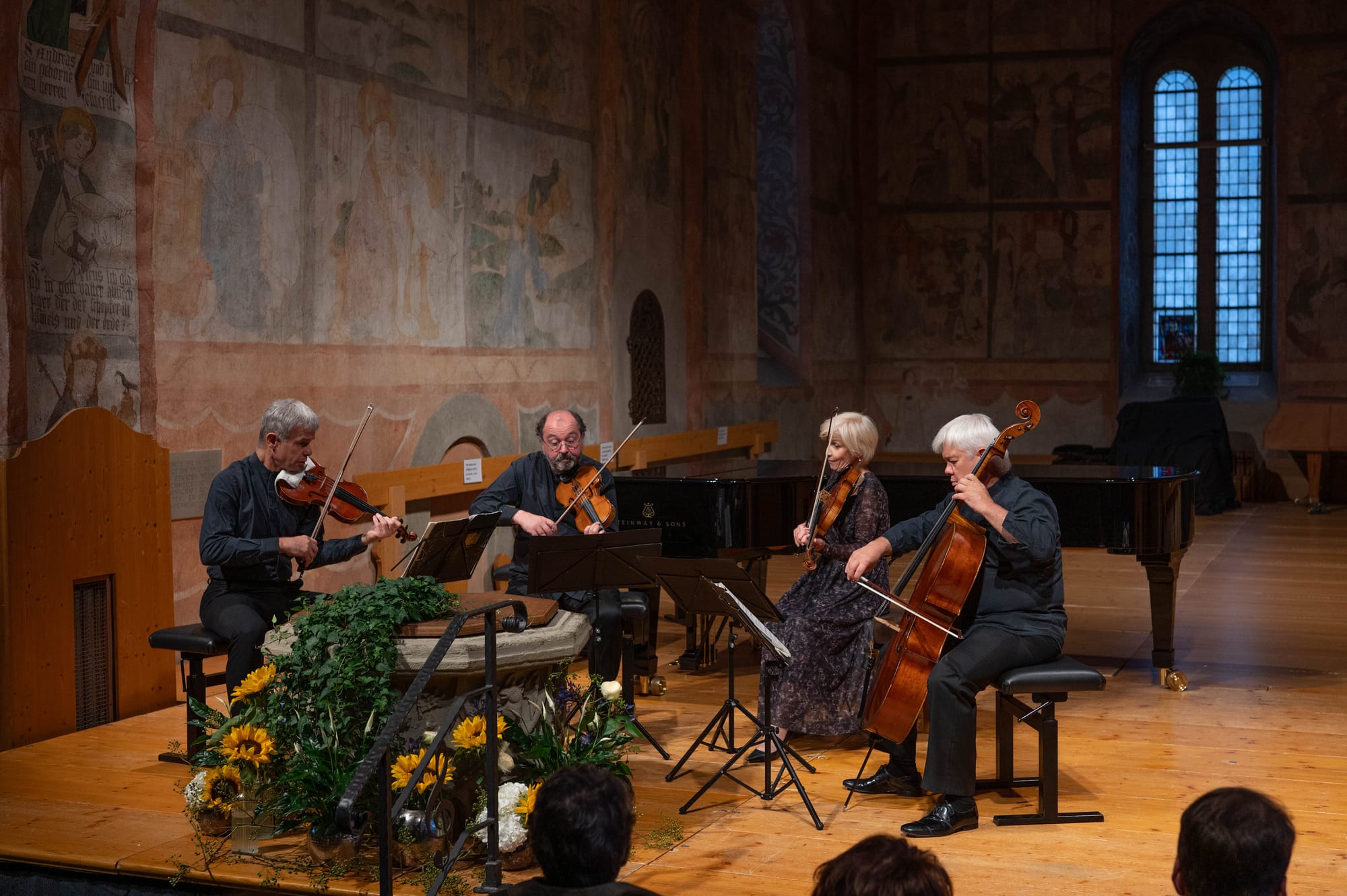
Contrasting this is the Adagio slow movement (‘Homage to the Dead’), chordal statement set against octave melody. This came across as one of Shostakovich’s most heart-felt and significant musical statements, Lukas Hagen’s first violin soliloquies particularly potent. Silences spoke volumes; but it was the performance of the finale that really seemed to underline Shostakovich’s genius in this quartet. No scampering close, more a study in melancholy, the piece ended with a moment frozen in time. An astonishing performance of a major quartet.
The YouTube playlist for the Hagen Quartet’s DG recording (plus Quartets 7 & 8) can be found here.
Brahms’ F-Minor Piano Quintet, in contrast, is an acknowledged masterpiece off the chamber répertoire. It is a piece that comes with quite a recorded pedigree, too, not lest Maurizio Pollini with the Quartetto Italiano on DG (January 1979, Herkulesaal, Vienna). Again, the Hagen Quartet is no stranger to the piece: they have recorded it with Kirill Gerstein for Myrios (that one recorded 2014 in the Kammersaal des Deutschen Rundfunks, Cologne, coupled with the Op. 67 String Quartet). You can find a link to the playlist for that Myrios disc here.
The Hagen Quartet clearly chooses its soloists carefully; Gerstein is a magnificently musical pianist in everything he plays (including Adès and Knussen); the same could be said for Mao Fujita, whose Mozart piano sonata cycle at Gstaad is the stuff of legend. His Mozart recordings on Sony have justifiably gathered global recognition. He was the pianist in the Brahms F-Minor Quintet. Fujita clearly has the ability to morph his sound to a given composer: compare the exquisite clarity of texture of his Mozart to the whispered intimacy of his Chopin Préludes, to the spicier tapestry of the Op. 11 Scriabin Preludes, and the quirky but often beautiful 24 Preludes by fellow Japanese Akio Tashiro (1929-76), all on another Sony release.
In terms of subtlety and nuance, Fujita is even finer than Gerstein. He plays like a true chamber musician; at the opening, He was far quieter than I, for one, expected, more like a shadow of the strings. And how Fujita flowered after that. The clarity one hears in his Mozart is there, too, in Brahms; never a hint of over-pedalling. Sudden blossoming of warmth from all created musical shape; and what left-hand clarity, too, from Fujita.
The players gave the Andante, un poco adagio space (Gerstein is arguably too fast); Fujita and the Hagen Quartet live gave us the epitome of Brahms’ tempo direction. It is ‘un poco,’ after all. This was a Brahmsian lullaby par excellence; and the smiles form the players said it all; as did the whispered moments. More than all that, though, was a recognition that when Brahms does pare down his textures, the effect is remarkably modern (not for doing did Schoenberg write a famous essay called Brahms the Progressive: it’s included in Style and Idea: follow this link for a full, free copy). Worth noting the fullness of tone Clemens Hagen can exact from his cello, too.
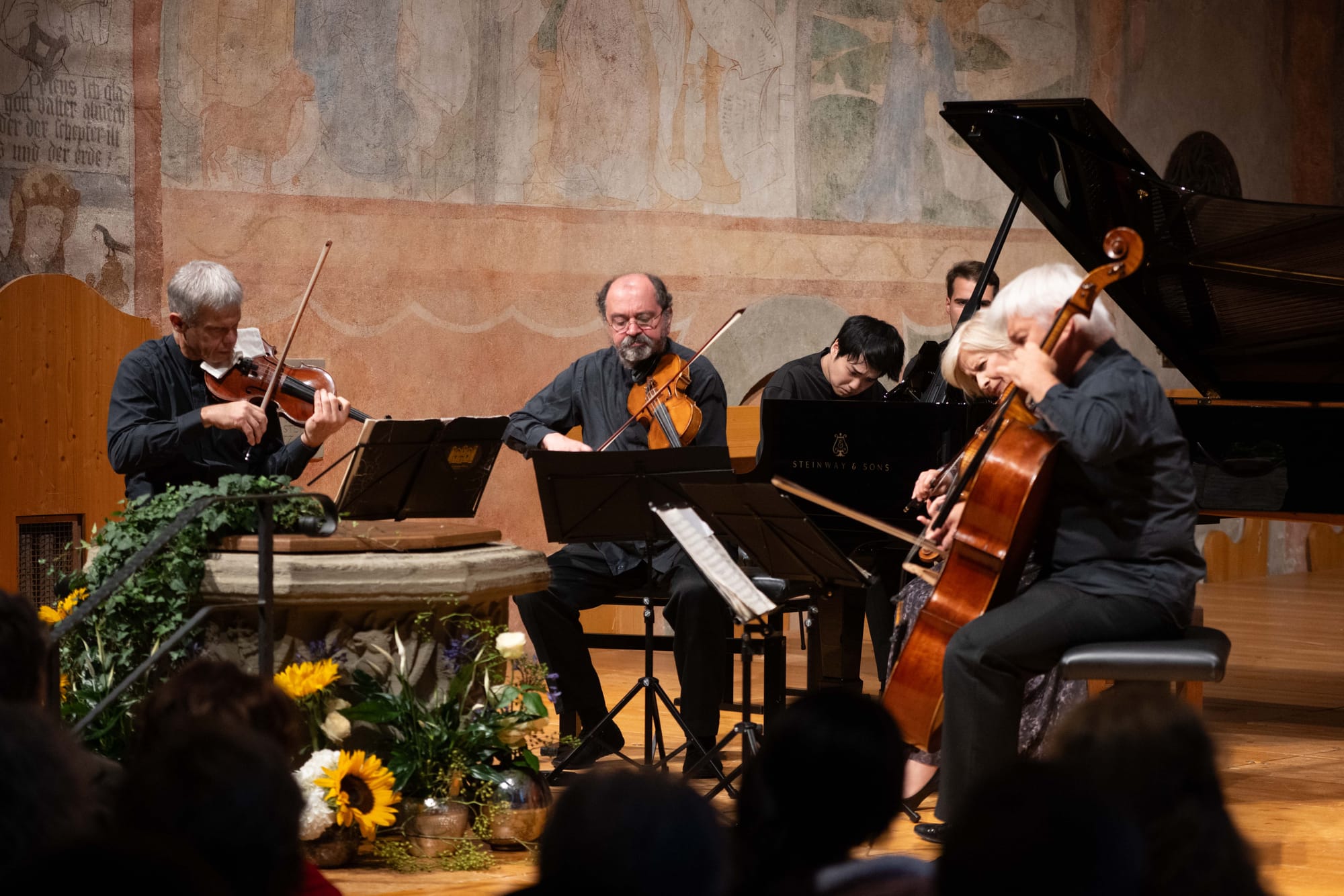
The Scherzo had life aplenty (far more than Gerstein’s account); but also, Fujita can maintain a chordal legato at the high dynamic levels bets than any pianist I have ever heard.
I think the Hagen Quartet had a masterplan in this coupling of Shostakovich and Brahms; the slow opening of the finale (Poco sostenuto) sounded so modern it seemed to link back (in terms of programme order) to the Shostakovich. And how Clemens Hagen’s cello honoured Brahms’ written embellishments so perfectly (joined in perfect unanimity by Veronika Hagen’s viola); Fujita mirrored them perfectly. Structurally, this movement’s is difficult to interpret and the Hagens with Fujita brought it off perfectly: including more hints of modernism.
A supreme performance; after Shostakovich Third Quarter, it felt as if anything else would be an anticlimax. Far from it; this was music making of the highest possible standard. Stunning.
The Hagem Quaet has also recorded the Brahms F-Minor Quintet with Paul Gulda, coupling it with the Schoenberg Op. 9 Chamber Symphony in an arrangement for piano quintet by Webern, but I find Gerstein preferable (Gulda is too literal). To complicate matters even further, there is a performance of the Brahms by the Hagen Quatet with Oleg Maisenberg from Lockenhaus that was released on Philips (the iDagio stream mislabels movements, unfortunately so I won’t include it). As to the Hagen Quartet live, I don’t believe I have heard them since their 2017 Wigmore Hall concert of Beethoven, Webern and Schumann (review); what a way to reacquaint myself!
The Gerstein/Hagen dic is available at Amazon here; the DG release of Shostakovich Quartets 3, 7 and 8 is available at Amazon here, but for a rather pricey £19.99.
